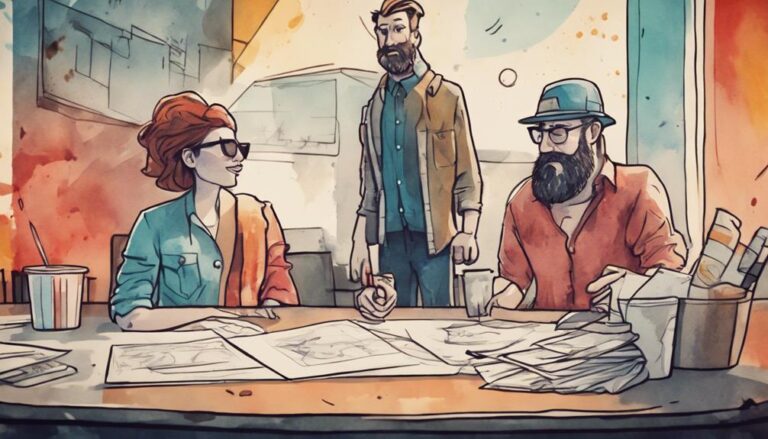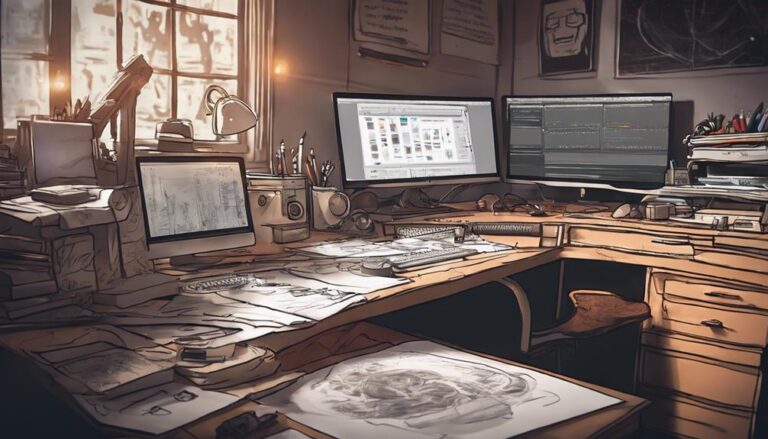Crafting Cartoon Characters With Unique Personalities
You're about to bring a cartoon character to life, but where do you start? You know you want them to stand out, to be more than just a generic hero or sidekick. The key lies in crafting a unique personality, one that's rooted in relatable flaws, skills, and quirks. By balancing strengths and weaknesses, you'll create a character that resonates with your audience. But what makes a character truly memorable? Is it their backstory, their mannerisms, or something more? You're on the cusp of discovering the secrets to making your character unforgettable – but you still have to uncover what makes them tick.
Key Takeaways
- Unique personality traits, skills, and flaws make cartoon characters relatable, memorable, and believable.
- Quirks, mannerisms, and habits add lovability and distinctiveness to characters, making them stand out.
- A character's past experiences and formative events shape their personality, values, and beliefs, influencing their actions.
- Consistency in vocal tone, speech patterns, and body language ensures authenticity and helps establish a character's baseline personality.
Defining Character Traits and Quirks
As you begin to breathe life into your cartoon character, start by defining their unique personality, skills, and flaws that will set them apart from the rest and make them relatable to your audience.
You want your character to be memorable, so think about what makes them quirky and lovable. Do they've a habit of twirling their hair when they're nervous or tapping their foot impatiently when waiting in line? Perhaps they've contrasting traits, like being a neat freak but having a secret love for messy, greasy foods.
Think about what skills your character excels in and what they struggle with. Are they a master of disguise or a clumsy athlete? What're their strengths and weaknesses?
Give them relatable flaws that your audience can identify with, like a fear of public speaking or a tendency to procrastinate. By defining these character traits and quirks, you'll create a well-rounded, believable character that audiences will root for.
Building Backstory and Motivations
As you craft your cartoon character, you're about to uncover the secrets that make them tick.
What past experiences have molded their personality, and what drives them to take action?
Past Experiences Shape Them
Your cartoon character's past experiences, like puzzle pieces, snap together to form the motivations that drive their actions and decisions.
These life lessons, gathered over time, have shaped their personality, values, and beliefs. Think about the formative events that have molded your character into who they're today.
Were they bullied in school, leading to a deep-seated fear of rejection? Did they overcome a childhood illness, instilling in them a sense of resilience and determination? Perhaps they experienced a traumatic loss, causing them to develop a protective shield around their emotions.
These past experiences have taught your character valuable lessons, influencing the way they interact with others and respond to challenges.
They may have developed coping mechanisms, such as humor or avoidance, to deal with difficult situations. Alternatively, they might've learned to stand up for themselves, becoming fiercely independent and confident.
Driving Forces Behind Actions
With these formative experiences in mind, you can now pinpoint the driving forces behind your character's actions, the underlying motivations that propel them through the story like a powerful engine fueling their every move.
As you excavate deeper into your character's psyche, you'll discover the moral compasses that guide their decisions and the inner demons that haunt them.
These driving forces can be broken down into:
Desires: What does your character crave? Is it power, love, or validation? These desires can drive their actions and shape their goals.
Fears: What're your character's deepest fears? Do they fear failure, rejection, or loss? These fears can hold them back or push them forward.
Values: What does your character stand for? What principles do they hold dear? These values can influence their moral compass and guide their decisions.
Traumas: What past traumas has your character experienced? How have these events shaped their worldview and behavior?
Crafting Dialogue and Voice
As you craft your cartoon character's dialogue, you're not just assigning words – you're breathing life into their personality.
The way they speak, the tone they use, and the witty banter they exchange with others can make or break their relatability and charm.
Vocal Tone Matters
When you breathe life into your cartoon character's vocal tone, their personality, background, and motivations start to shine through in every spoken word, revealing the nuances that make them relatable and endearing to audiences. It's not just about what they say, but how they say it – the cadence, pitch, and volume that convey emotions and attitudes.
To craft a vocal tone that resonates with your audience, consider the following:
Tone authenticity: Verify your character's voice aligns with their personality traits, history, and motivations. This consistency will make their dialogue feel more genuine and engaging.
Emotive resonance: Infuse their vocal tone with emotions that echo their inner world. This will help your audience connect with them on a deeper level, making their experiences more relatable and memorable.
Regional accents and dialects: Use distinct speech patterns to add flavor and authenticity to your character's voice. This can also reveal their background, upbringing, or cultural heritage.
Idiosyncratic speech patterns: Give your character unique verbal tics, such as catchphrases, stutters, or mannerisms, to make their voice truly one-of-a-kind.
Witty Banter Essentials
Your cartoon character's vocal tone is more than just a pleasant sound; it's a key to revealing their personality, and now it's time to put that tone into action with clever, engaging dialogue that sparks witty banter.
When crafting dialogue, think of it as a dance – a back-and-forth exchange of words that reveals character traits, relationships, and motivations.
To create witty banter, you'll need to inject your character's dialogue with a healthy dose of sarcasm, irony, and humor.
Sarcastic remarks can be a great way to add humor and depth to your character's interactions.
Imagine your character rolling their eyes and saying, 'Oh, great, just what I needed, another thing to do today.'
This kind of quick wit can make your character relatable and endearing to audiences.
When responding to others, your character's dialogue should be snappy and clever, with a touch of playfulness.
Remember, the goal is to create a sense of chemistry between characters, so make sure their interactions feel natural and authentic.
With clever dialogue and witty banter, you'll bring your character to life and make them unforgettable.
Designing Expressions and Body Language
Bring your cartoon character to life by crafting a range of expressions and body language that convey their unique personality, emotions, and traits.
You want your character's face to be a canvas of emotions, with subtle Facial Contortions that reveal their thoughts and feelings. A raised eyebrow can signify skepticism, while a downturned mouth can convey disappointment.
But it's not just about the face. Posture Signifiers can also speak volumes about your character's personality. A slouched posture can indicate laziness, while a straight back can suggest confidence.
Experiment with extremes: Push your character's expressions and body language to the limit to see what works and what doesn't.
Keep it consistent: Establish a baseline for your character's default expression and posture, and then deviate from it to convey different emotions and traits.
Pay attention to context: Consider the situation and environment your character is in, and adjust their expressions and body language accordingly.
Study real-life references: Observe people's expressions and body language in real life, and use those observations to inform your character's design.
Balancing Flaws and Strengths
As you fine-tune your character's expressions and body language, it's time to inject a dose of humanity by balancing their flaws and strengths, for a lovable hero is often one who stumbles, and a formidable villain is one who's not invincible.
Think of it as crafting a delicate recipe: too much sugar (perfection) makes the character unrelatable, while a dash of salt (imperfections) adds depth and complexity.
Moral ambiguities make characters more nuanced, allowing them to exist in the gray areas between good and evil.
Give your hero relatable insecurities, like a fear of failure or self-doubt, to make them more endearing to your audience.
On the flip side, your villain can have a redeeming quality, like a tragic backstory or a twisted sense of justice, to make them more formidable.
By striking a balance between flaws and strengths, you'll create a character that's both believable and compelling.
Bringing Characters to Life
With a dash of creative flair, you can breathe life into your characters by infusing them with unique mannerisms, quirky habits, and distinctive speech patterns that set them apart from the crowd.
As you craft their personalities, remember that character nuance is key to creating emotional resonance with your audience.
To bring your characters to life, try these techniques:
- Give them a signature gesture: A flick of the wrist, a tap of the foot, or a distinctive way of tilting their head can make your character instantly recognizable.
- Develop their verbal tics: A catchphrase, a stutter, or a peculiar way of pronouncing certain words can add depth and humor to your character's interactions.
- Make them move with intention: Whether it's a swagger, a slouch, or a bouncy gait, your character's physicality can convey their personality and mood.
- Infuse their dialogue with subtext: What they say versus what they mean can create a rich layer of emotional resonance and character nuance.
Frequently Asked Questions
Can I Create a Character Based on Someone I Know in Real Life?
You can totally create a character inspired by someone you know in real life! Translate their quirky personal traits, like their laugh or mannerisms, into your character's unique features, and watch them come alive with real-life charm!
How Many Characters Should I Have in My Cartoon Series?
You're building a world, and the number of characters is vital! Aim for a diverse ensemble cast, where each one serves a purpose in the story, and has their own character arc to unfold, making your series rich and dynamic.
What if My Character's Personality Contradicts Their Appearance?
"When you clash a character's personality with their appearance, you create visual irony, and that's where the magic happens! Think of a gentle giant or a tough-looking softie – the physical mismatch sparks curiosity and makes them more relatable."
Is It Necessary to Have a Villain in Every Cartoon Story?
You don't need a villain in every cartoon story, but a well-crafted one can elevate the narrative. Consider a complex, morally ambiguous villain with motivations that blur the lines between good and evil, making your heroes' triumph more satisfying.
Can My Character's Personality Change Over the Course of the Series?
As you weave your story, you'll find your character's personality can shift like the tides, following a trajectory of evolution, where they learn, grow, and transform, unfolding a rich tapestry of character growth that captivates your audience.
Conclusion
As you breathe life into your cartoon character, remember that uniqueness is key.
By masterfully blending flaws and strengths, quirks and mannerisms, you'll craft a personality that resonates deeply with your audience.
Your character's rich backstory, motivations, and dialogue will make them relatable and memorable.
With every carefully designed expression and movement, they'll leap off the page, mesmerizing hearts and minds.
Now, set free your imagination and let your character shine – the world is waiting to fall in love with them!






